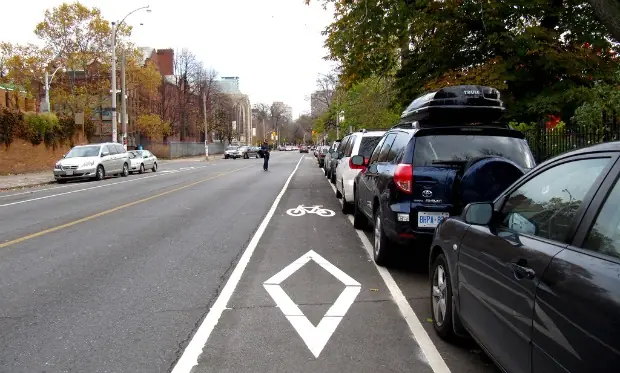
Whatever your story, your background, one thing is common -- and paramount -- amongst all people who ride a bike: safety. Everyone has heard the adage "it's not if, but when." Specifically, I am talking about cycling on the road with our four-wheeled counterparts. And it is true: there will be a time where you, or someone you know is involved (or nearly involved) in a collision with a motorist. Yes, wearing a helmet and following the rules of the road are of utmost importance and should never be compromised or abandoned. However, avoiding an accident in the first place should be the main objective.
Unfortunately, an accident with another driver is not always in our control; but being cognizant of the most common types of bicycle-car collisions can help us to ride defensively and ultimately decrease our chances of injury, or worse.
The most common collision with a motorist happens when a cyclist is headed straight and a car is turning right, onto the same trajectory of the bike. Either the car collides with the cyclist, or the cyclist is unable to stop and slams into the car. As the cyclist, you must always be aware of your surroundings; when this situation presents itself to you, move further left if safe to do so, slow down in advance, and look the driver in the eye. If you are unsure whether or not the driver has seen you, wave your arm. Wearing a headlight (yes, even in the day), bright colors, and/or adding a small bell to your bike can help.
Another common collision happens when a cyclist is struck by the sudden opening of a parked car's door. Believe it or not, this is very common and can cause fatalities. Tip: to avoid this scenario, ride to the left, about the width of a car door, when passing parked cars on your right. Make sure not to swerve in and out of the bike lane; stay consistent and predictable. The cars behind you are legally supposed to share the road with you, and this scenario is no exception. When it is appropriate, such as at intersections or in more congested/urban areas, do not hug the curb. This makes you less visible, and encourages some drivers to forget that you are, in fact, entitled to the same road they are driving on. Drivers sometimes assume you can stop quickly or that "the bike can wait." Do not lend yourself to this vulnerability.
Other common types of car-bike accidents happen with a car is making a left turn, right in front of an oncoming cyclist.. Again, the driver may not see you or they might assume you are leisurely plugging away at 8 mph. Not true for most cyclists. To avoid this, DO NOT RIDE ON THE SIDEWALK (unless absolutely necessary and for very short distances). Motorists will often scream "SIDEWALK!"(followed by some other choice words) to cyclists riding on the road; this is illegal and completely unsafe. The speeds are entirely too fast, even at a leisure pace, for a sidewalk and can cause injuries and fatalities. Slowing down at intersections can also help immensely.
Being hit from behind is a common fear among cyclists but actually only comprises about 3.8% of all collisions (source: bicyclinglife.com). This risk can be minimized by wearing bright, reflective clothing -- even during the day -- and by assuming a predictable riding style.
To summarize, and to add a few more general tips, here are some of the basics of bicycle safety on the road:
1. Wear bright reflective clothing, even in the day time hours
2. Wear a blinky light or headlamp, no matter the time of day you are riding
3. Avoid wearing headphones, at least not in both ears
4. Slow down at intersections
5. Look drivers in the eye when a potentially dangerous situation might ensue; be sure they see you
6. Be predictable, and, signal your turns
7. Always look behind you or in a mirror before veering/swerving left into the lane of traffic
8. Do not ride on the sidewalk
9. Wave your arms if you are unsure of your visibility, especially at intersections or with cars turning right, into your lane
10. When appropriate, do not hug the curb too much; leave yourself some space to veer into if necessary; be visible (do not do this on fast or rural roads!)
11. ALWAYS wear a headlamp and a rear light when riding at night
12. Wear. A. Helmet. Always.
13. Follow the rules of the road, as if you were driving a car
14. Ride defensively: like every driver is on a cell phone, not paying attention, on drugs (a common habit as of late); never give a driver the benefit of the doubt when it comes to your life!
Please do not take chances; bicycling is a healthy, fun, enjoyable way to achieve a wide variety of objectives. Let's keep our community strong, fit, healthy, and SAFE. You take a risk every time you climb onto your bicycle: do your part to keep yourself and others as safe as possible.
Jen Schmidt, PT, DPT, OCS, is a physical therapist at Beyond Exercise. The Cincinnati-based clinic specializes in physical therapy and athlete development for people and athletes of all abilities.
Recent Articles:
- The 80-Minute Training Plan
- Lose the Belly Fat: Weight Management for Triathletes
- 5 Reasons to Join a Collegiate Triathlon Team
Connect with us on Twitter, Facebook, Instagram or Pinterest for more tips, recipes and ideas to fuel your ACTIVE life.
 Put your mental strength to the test. Sign up for a triathlon.
Put your mental strength to the test. Sign up for a triathlon.


